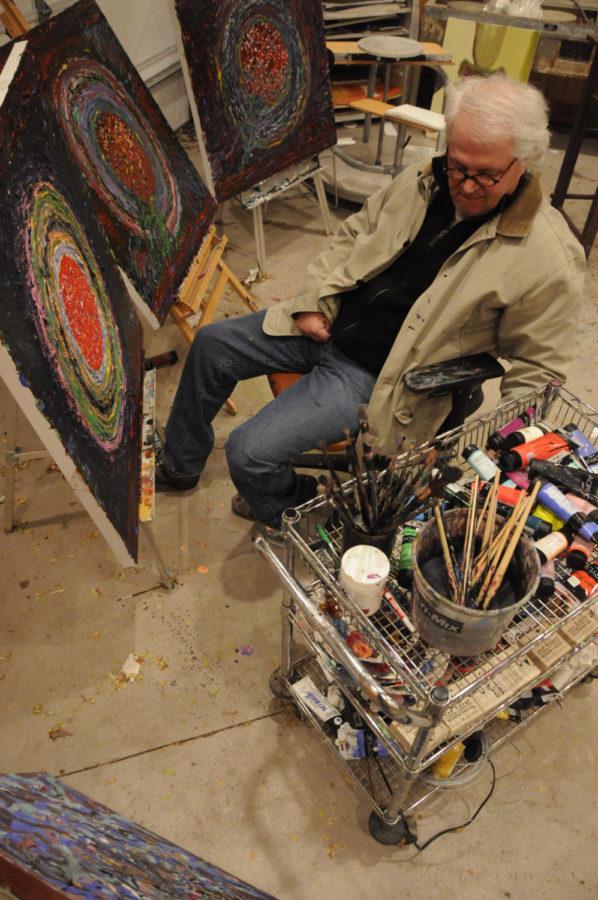ISU professor uses art as his voice
Steven, who suffered a stroke in 2008, uses painting as a form of therapy as suggested by his daughter Lyndsey Nissen.
January 23, 2014
After 26 years of teaching and inspiring students at Iowa State, Steven suffered a serious stroke impairing his speaking abilities. He turned to using paint and canvas as his voice.
Steven, a former ISU professor from the animal science department, survived a stroke six years ago. His daughter suggested painting as a means of therapy.
His artwork will be displayed at Design on Main Jan. 24.
Steven suffered a stroke in 2008 and began painting two years later.
“He had a stroke, a massive stroke and it was on the left side of his brain and that affects the language areas on the right side of the brain … all of his language was affected by the stroke,” said Holly Nissen, Steven’s wife.
His daughter Lyndsey Nissen has played a key role in his newfound artistic career. Lyndsay is currently an ISU graduate student in integrated studio arts.
Holly said that her daughter was very instrumental in getting him started with painting because she is an artist.
“I thought maybe, … maybe he would like to paint,” Lyndsay said. She would bring all of his stuff into the living room, put a canvas in front of him and give him paint. “He just took off.”
Lyndsay said that she would think about not painting anymore after her father started because he was so good.
“He has always been a very creative, inventive person and this is a way for him now to get some of those creative ideas and thoughts out,” Holly said.
Steven’s work is mostly abstract using acrylic paints while working his science background into the paintings.
“He does do things inspired by mostly nature around our house and our family,” Lyndsay said.
Before the stroke, Steven was an active member of the ISU and Ames communities. He holds three degrees from Iowa State: a doctorate of veterinary medicine, a masters and a doctoral degree in animal science. He also did a postdoctoral fellowship in pediatric endocrinology at the Mayo Clinic in Rochester, Minn.
Holly said that he started a winery in downtown Ames called Prairie Moon Winery, which has hosted a gallery showing his artwork.
He worked with students as the codirector of the agricultural entrepreneurship program. Working with students to come up with their own ideas and develop their own businesses. Steven also worked with the ISU Research Park. He had a company out at the research park called Metabolic Technologies, Inc.
“They had a seminar in his honor this past May through the animal science department, quite a few of his graduate students came back for it. It was called the Nissen Symposium,” Holly said.
He made such an impact on his students that when he was in the hospital after the stroke a few of them came to visit him.
Steven keeps his voice strong through paintings. He can speak few words and phrases and can only use the left side of his body. Being right handed, that caused him to learn how to paint with his left, non-dominant, hand.
“He was [very active]. He was so many things going on and so many ideas … and to all of a sudden not be able to express yourself and be out there doing the things you love to do, there is a sense of frustration with that,” Holly said.
Lyndsay suggested that his paintings be displayed in Design on Main to bring in the ISU community that her father is so connected with.
“When Lyndsay proposed the idea she thought it would bring in people from all over Iowa State and not just the College of Design,” Holly said.
Right now he is working on a cell series that will be displayed at the gallery.
“He’s got different themes but he usually does them in little sets,” Lyndsay said.
Steven really enjoys giving his paintings to people according to his wife and daughter.
“He loves to give to his family, so he gives them away to everybody that comes over and they love them,” Holly said.
Holly said that most of the paintings are going to be for sale unless it is one that the family really wants to hold on to.
“If you ask, he will probably give it to you,” Lyndsay said.
Steven’s artistic talent has not been apparent throughout his whole life. He started painting two years after the stroke and flourished.
Lyndsay spoke about where his talent of painting could have come from.
“It’s more interesting when it’s not explained,” she said.







